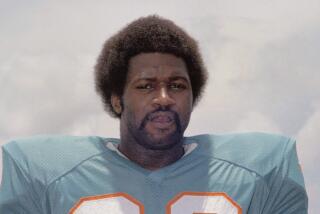Breaking Down Another Barrier
- Share via
Doug Williams, who led the Washington Redskins to a football championship Sunday, says it didn’t matter that he was the the first black quarterback to start in the Super Bowl. But his absolutely stunning success in the championship game will help break down the invisible barriers that exclude black Americans and other minorities from the best or most sought-after positions in sports and other fields.
Black athletes are no strangers to professional football. They make up the majority--51%--of the National Football League roster. Although there is no shortage of talent, black quarterbacks are nearly non-existent; only three are starters. The barriers are pretty firmly in place.
Quarterback is considered a thinking man’s position, a glamorous and powerful leadership slot for the athlete who can act quickly and adjust to changing situations. Although black quarterbacks have played college ball, they are typically asked to switch to wide receiver or running back in the pros. That is just the way it has been.
That Williams led Washington to victory is ironic because of the team’s racial history. The Redskins were the whitest team in the league and the last team with no black players. That didn’t begin to change until 1961, when the all-white team moved into a new stadium, owned by the government and managed by the Interior Department. Then-Interior Secretary Stewart Udall made it clear that only an integrated team would be allowed to play in what would come to be known as Robert F. Kennedy Stadium. The team’s owner, George Preston Marshall, traded for his first black player that year, nearly two decades after black athletes began playing for other teams in the league.
Williams, the Most Valuable Player in the Super Bowl, may not want credit for breaking down yet another racial barrier. But his record-breaking victory is expected to multiply opportunities at the top for black Americans on and off the field.
More to Read
Go beyond the scoreboard
Get the latest on L.A.'s teams in the daily Sports Report newsletter.
You may occasionally receive promotional content from the Los Angeles Times.










